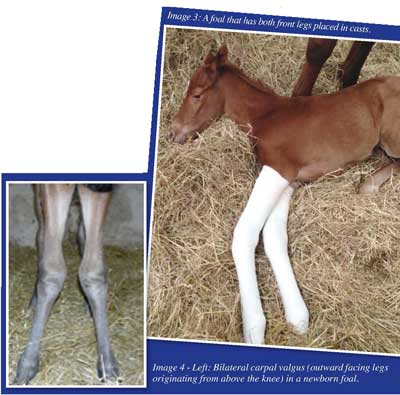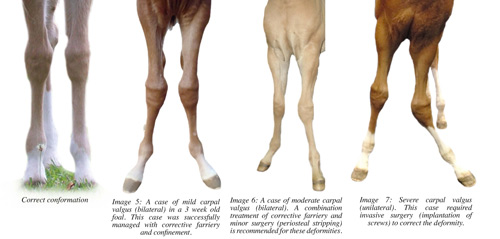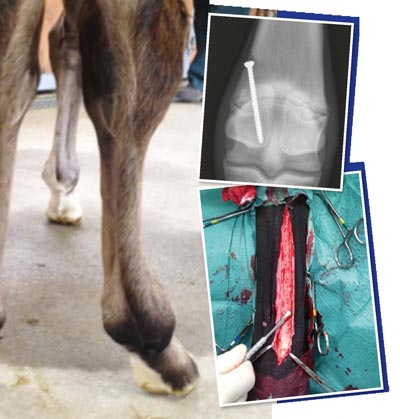
With the breeding season almost completed the majority of foals are already on the ground.
It is not uncommon for many of these foals to be born with ‘bent legs’ (angular limb deformities), however there are methods that can be used to manage such foals.
Angular limb deformities refer to a deviation of the foal’s leg/legs either outwards or inwards. Even slight angular limb deformities are undesirable in adult horses, as the abnormal angles on the joints will predispose them to orthopedic problems such as osteoarthritis. While many foals are born with some degree of limb deviation, mostly due to muscle weakness and lax ligaments, this will usually correct itself as the foal exercises. There is, however, always a risk that exercise may cause damage, depending on the cause of the limb deviation. To determine the most effective treatment for correction of this condition, it is best to have a veterinarian and / or farrier examine the foal.
There are several causes of angular limb deformities and hence, many different treatment options. It is extremely important to select the most appropriate treatment regime in order to maximise the outcome for horse and owner.
The causes of these deformities can be placed into two main categories:
1) Factors associated with pregnancy and the immediate period following birth; including genetic factors, incomplete bone formation (ossification) of the cuboidal bones (small bones within the hock or knee joints) and laxity (slackness) of supporting joint structures (e.g. ligaments).
2) Developmental factors that occur following birth; including unbalanced nutrition and excessive exercise or joint trauma.
Radiographs may be required to determine whether the deformity is originating from a growth plate (see image 1), the most common site, or ascertain the presence of other sinister underlying conditions. Some deformities occur when the foal is premature and the cuboidal bones in the joint have not formed (see image 2). These cases need to be managed very differently to limb deformities originating from a growth plate disorder.
Incomplete bone formation (ossification) can be a result of premature birth or any disease that has affected the mare during pregnancy. Placentitis, heavy parasite infestation and even colic may interfere with development of the foal and result in incomplete ossification of the cuboidal bones at the time of birth.
If the angular deformity has originated from a case of incomplete bone formation the foal should be managed with strict rest and splinting/casting of the limb (see image 3). The purpose of casting is to maintain the limb in proper alignment while the bones form (ossify).
It is essential that these foals are not allowed to exercise or the joints may develop abnormally and become arthritic. Some foals require up to a month of confinement before the bones are ossified. 
A considerable number of newborn foals have limbs that are not straight (see image 4), however this is not necessarily cause for panic!
A large proportion of these will straighten within the first week or two of life. For angular limb deformities that do not self-correct there are both conservative and surgical options available.
The images above are cases of mild to severe outward deviation of the limb (carpal valgus) deformities (see image 5, 6 and 7). All these deviations are originating from the growth plate. Most mild cases can be managed with conservative treatment while the more extreme cases require invasive surgical intervention. Moderate cases can be managed conservatively initially and depending on their response surgery may or may not be required.
Conservative management is usually attempted first in young foals or if the angulation of the deformity is only slight. This involves corrective rasping of the feet, confinement (stall or small yard) and sometimes the addition of therapeutic hoof extensions (see image 8). These procedures will alter the biomechanics of the limb and straighten the leg over time. Most angular deformities will correct with this method of treatment over several weeks. Ongoing rasping of the feet is required every two weeks until the legs straighten. The length of confinement will also vary depending on the severity of the issue.

Occasionally these relatively conservative treatments are not appropriate to straighten the limb and surgical intervention will be required. It is essential for foals that fail to respond to conservative treatment within the first month of life to be referred to a veterinarian to help make a decision in regards to further treatment. Surgical interventions must be performed prior to the limb’s growth plate closure. Growth plates are present in the bones of young horses, however they will disappear with time. Once growth plates are ‘shut’, correction of an angular limb deformity is almost impossible. 
As a guide, fetlock growth plates will be closed once a foal reaches six to eight weeks of age. Carpal growth plates stay open for a longer period of time, however correction is always easier and faster in younger animals.
Surgical correction of angular limb deformities includes growth acceleration (periosteal stripping) and growth retardation (transphyseal bridging), (see Insert top). Surgically accelerating or retarding bony growth on the appropriate side of the growth place can help to correct angular limb deformities. These procedures are typically performed in foals that are between two and five months old, depending on the surgical procedure desired and the joints affected.

Occasionally the deformity will be originating from the middle (diaphysis) of a long bone and require different management (see main image). Such cases will require a combination of conservative management and surgical correction (see Insert bottom).
There are many options for correcting angular limb deformities in foals and, when detected early and managed appropriately, the prognosis for this condition is usually excellent.
|